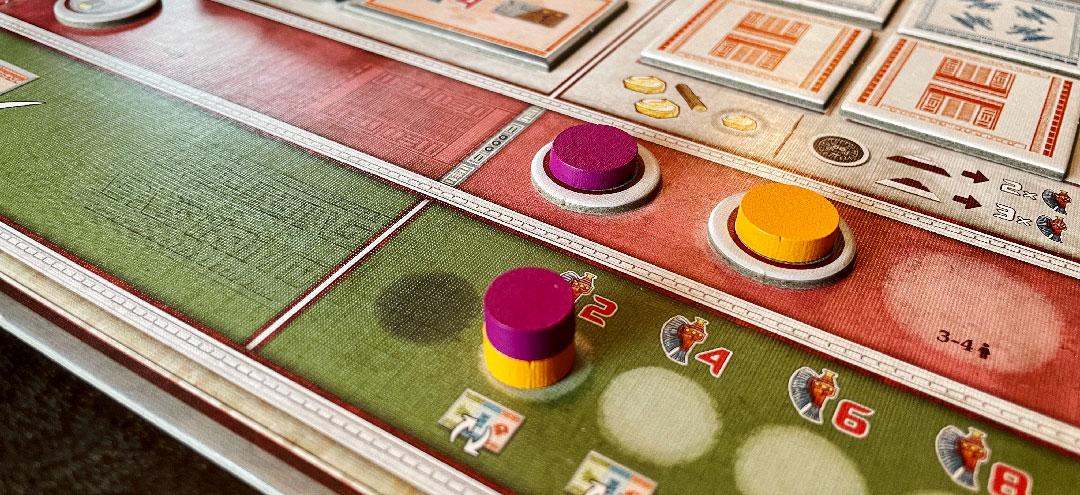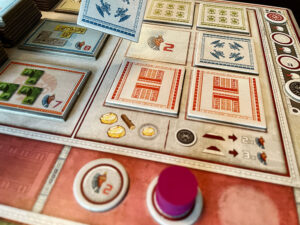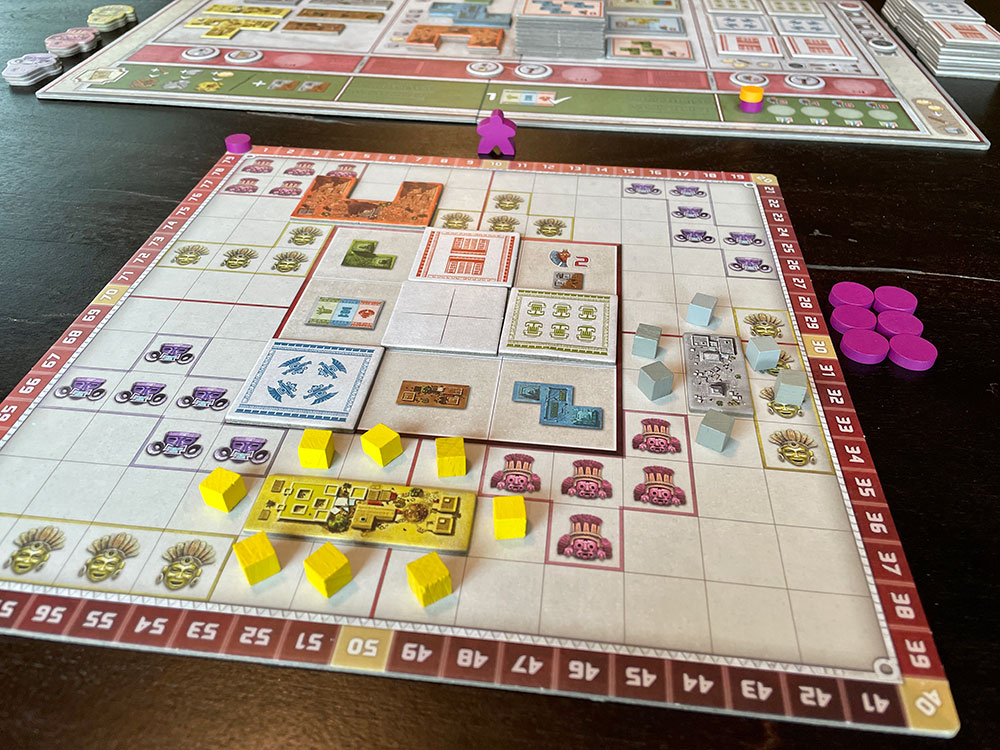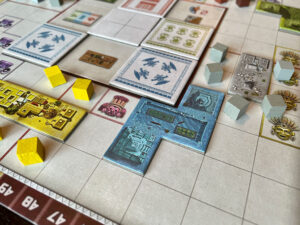
 Brandon steps up to the podium, surveys the crowded auditorium, and quickly clears his throat. “Today I’d like to present to you my vision of the next great Mesoamerican city. As you can see from the scale model on my slide, I’ve added the most luxurious production buildings. We have centers for wood, stone, and gold. There’s space for majestic temples in a variety of colors (three to be exact). And in the center of it all: the three-story pyramid.”
Brandon steps up to the podium, surveys the crowded auditorium, and quickly clears his throat. “Today I’d like to present to you my vision of the next great Mesoamerican city. As you can see from the scale model on my slide, I’ve added the most luxurious production buildings. We have centers for wood, stone, and gold. There’s space for majestic temples in a variety of colors (three to be exact). And in the center of it all: the three-story pyramid.”
The crowd shifted as murmurs arose. “Where will we buy food?” “Where are the shopping centers?” “Are there no parks for my children?” “Why is the pyramid so small?”
It’s hard to please everybody with your vision of the future. Designer Filip Glowasz and publisher Board & Dice set out to tackle a question as old as time itself. “What if we made a lightweight spiritual successor to one of our modern classics—Teotihuacan?” Well, they’ve done it. But will the tile-laying city builder be enough to please the crowd?
Gameplay Overview:
Founders of Teotihuacan is all about utilizing actions efficiently to maximize the attractiveness of your vision of the city. This attractiveness is measured in points that players track on their individual player boards. Included on these boards are a centralized pyramid area, as well as four sections (quadrants) where you can place built production buildings and temples.

Players begin with five action disks and one of each color of pyramid tile to place in their central area. Gameplay lasts four rounds and each round, players must discard one disk, thus making actions decrease over time. These disks are utilized to take actions on a centralized board that is split into a top and bottom section, as well as three action areas for each.
The top section is the build area. When choosing one of the three build action areas, players construct a production building, a temple, or a pyramid tile. The bottom section is the influence area. When choosing this area, players produce resources, make an offering by activating a worship tile, or gain favor.
Each section has multiple spaces to place disks, with each space able to hold a maximum of three disks. Players choose how many to use on their turn. The first to place on a space also gains a bonus from the bonus disk that’s been seeded at the start of the round. The number of disks used determines how powerful the action is. For example, placing two disks onto the “construct a building” space allows a player to build a level three production building. Players can place on top of other played disks if they don’t exceed the limit. And once they’ve used up their disks, players cannot play further that round.

When building, players select the option they’ve built and then bring the tile back to their player board. Players must choose where to place the tile before their turn ends, and they can only place the tile in one of the two quadrants where their architect is located. This architect moves to the next clockwise side of the board at the end of each turn, and it is important to be mindful of when strategizing.
Placing a production building allows players to add resources around the outside of the tile for use later. A temple doesn’t add resources and takes up much needed space, but it scores points at the end of the game for any matching pyramid tiles in its quadrant. Building a temple also grants the player a worship tile of the corresponding color. And the pyramid tiles must correspond to the temple color to score. At the end of the game, they award two points per matching temple if built on the first level, or three points if on the second or third level.
Whenever a section of mask symbols is covered up by buildings, that player will be able to claim a mask tile of the corresponding type. The points on these tiles decrease over time, so getting to these early can be important. The other major way to score points is from activating worship tiles which can prove to be very effective and can also provide powerful combos.

Game Experience:
The first question many will have is: “how does this compare to Teotihuacan?” The simple answer is that beyond the name and iconography/resource similarities, these are two very different games. Looking closer though, there are several elements from the original game here, including the clockwise movement, the building restrictions, and the way workers combine to affect actions. Truly they share very little and exist in realms of their own, which isn’t necessarily a bad thing.
There are several quality design choices, and they exist in different spaces. First, the central board’s action selection provides plenty of contemplation. Do you take a weaker action, get the bonus, and leave space for an opponent to take a stronger action? Do you take a more powerful action and have less action disks to use for the round? These choices coincide with the desire to reach certain buildings or temples first, since there is limited supply each round, as well as seeking worship tiles that fit your strategy before they’re taken.

The player board design space is also intriguing. The restriction of the architect’s reach has had a significant impact on my decisions and requires being mindful of when and where to place buildings. The other restriction that feels great is how each building that’s added to your board slowly starts to restrict space. With each resource you add to your board, you’re adding a potential barrier to the next production or temple tile. Balancing what to build and when to use resources becomes a mini-game all on its own.
With all that said, after a few plays, Founders of Teotihuacan starts to show some faults. The first relates to replay value. Player boards have an asymmetrical side, but there’s not enough variability to create unique plays. The worship tiles show up at different times during the game, but typically you can see a high number of them through a single play to the point where you can begin to seek the point scoring opportunities you want. And while the end round bonus disk shuffle and reseed adds some variety, there are multiple of each disk, so it isn’t restricting enough.

Another area of this game that struggles is the component quality. My copy had resource cubes of varying shades of color. The action disks are uninspiring and the pyramid tiles pale in comparison to the tactile experience of Teotihuacan. In fact, it doesn’t seem like you’re building a pyramid at all, but rather a three-story office building in the center of your board. The iconography on the worship tiles is also not as intuitive as it could have been, leaving us consulting the rulebook during play.
I’ve enjoyed my plays of Founders of Teotihuacan best at two and four players. The three-player game being limited to three rounds feels too short. And this is a quick playing game, with our play times coming in at about an hour or less. The continual loss of action disks keeps the game focused and makes you wish you had more time, but at three player it feels like the design needed more consideration.
Final Thoughts:
So, is Founders of Teotihuacan a step toward the future of the great Mesoamerican design? I’d say there are more misses than hits here. The first plays are intriguing, but after some time it feels like you’ve seen much of what it has to offer. As such, this seems like it would appeal most to those seeking a more complex tile-laying game that still plays in a short amount of time. Another thing of interest here is how minimized the pyramid building feels. I felt this way as well with Teotihuacan, especially as more expansions emerged. The game sprawled into new point-scoring opportunities and left the majestic buildings in the dust. Here the pyramids feel the same. Expensive to build. Provide some points. Shrug. It’s as if Founders of Teotihuacan forgot that players still want to feel like they’ve completed something impressive at the end of the day.
Final Score: 3 stars – A tile-laying city builder with some unique ideas that don’t rise above the desire for something more majestic.
 Hits:
Hits:
• Architect restrictions
• Disk placement decisions
• Swift playtime
Misses:
• Lackluster components
• Replay value
• Pyramid building
• Worship tile iconography






















